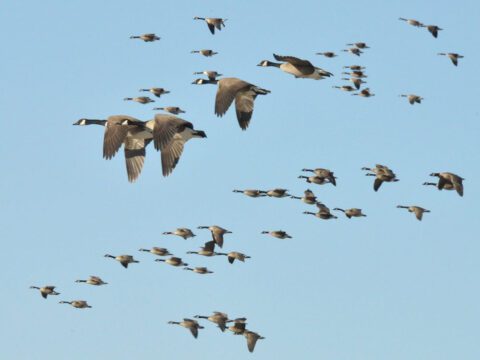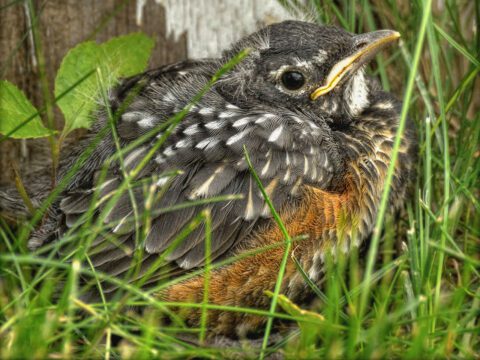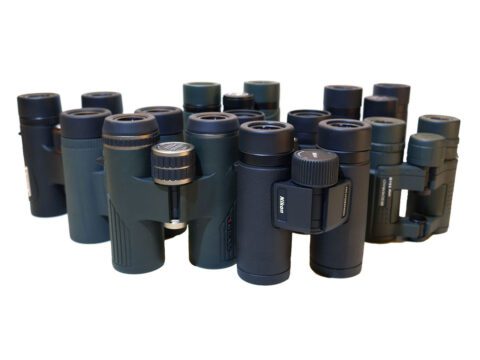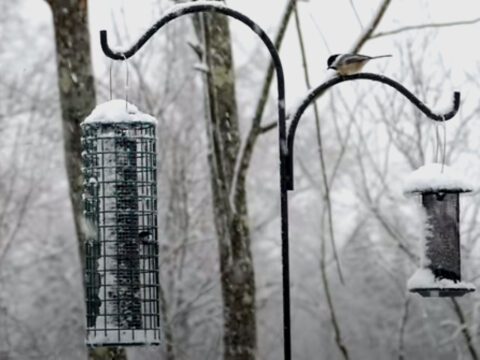World Birding Rally: In Peru’s Cloud Forest, Royal Sunangel Looks as Impressive as it Sounds
By Hugh Powell May 19, 2014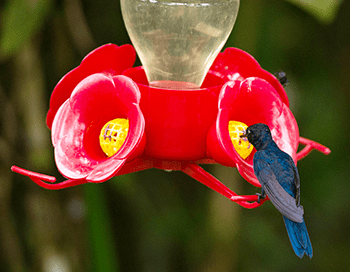
On Day 6 of the World Birding Rally, a poorly timed landslide almost swept away my chances of seeing the spectacularly (and appropriately) named Royal Sunangel. The rally started today in the valley of the Utcubamba River, climbed over a pass in the Alto Mayo cloud forest (where I had hoped to see the sunangel), and descended to the Amazonian foothills of Tarapoto, Peru. The change in habitats meant a big jump in bird lists, and by the end of the day the Sunbird/Wings team had a narrow lead over the other three teams (see below for full standings).
I had wanted to find a Royal Sunangel ever since reading about its discovery in 1975 by a young graduate student named John Fitzpatrick. He later described it in the Wilson Bulletin as “a common, small, midnight-blue hummingbird occupying the brushy slopes bordering moist cloud forest.” The paper includes a watercolor Fitzpatrick painted of a pair against just such a backdrop.
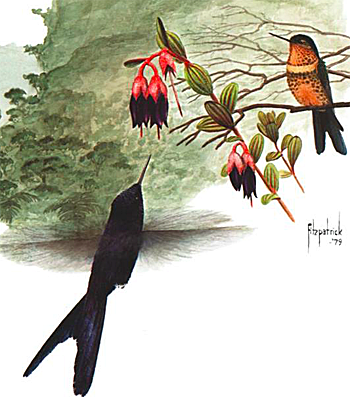
Fitzpatrick (Fitz) went on to an influential scientific career and is now the director of the Cornell Lab of Ornithology. When I asked him about that expedition, he said, “That was the era when almost every year people were getting to new places and finding new stuff, especially up in northern Peru.” The 1975 trip, which Fitz described as “really just a lark,” was no exception. The first bird he caught on the first morning, was a new wren, now called the Bar-winged Wood-Wren.
Later, he and his colleagues noticed an unusual hummingbird feeding from flowering shrubs at the forest edge. Though the wood-wren had immediately stuck out as a new species (“There were only two other species of wood-wrens, and neither of them have wing bars,” Fitz said), he couldn’t be sure the hummingbird was undescribed. At the time the only reference was a book that had no pictures and covered all of South America. “We were leafing through 300-plus species of hummingbirds, and we were confused the entire time,” Fitz said.
After a second expedition the next year, the team had enough information to call it a new species. In those days before genetic analyses, details such as the feathering around the nostrils put the bird squarely in the genus of sunangels. “When we knew it was new,” Fitz told me, “I thought, we’ve gotta find some good name for this thing. I thought, it’s royal blue, why not Royal Sunangel?” Heliangelus regalis was born.
Even now, the known range of the Royal Sunangel involves only a few mountain ranges in Peru and Ecuador, at elevations between about 4,400 and 7,400 feet. This visit to Peru was going to put me in the small part of the globe where these birds exist. But I almost missed them anyway.
The trouble had started the night before with unusually heavy rain for this time of year. In the narrow and steep Utcubamba valley, that translated to a heavy mudslide that buried the road in deep, wet sand and boulders the size of coffee tables, stopping our day before dawn had fully broken.
A single bulldozer was at work, but it promptly ran out of gas. Later, a man arrived with a bucket of tamales and began selling them to people waiting. A steady stream of passengers picked their way around the blockage carrying belongings, suitcases, children, and sacks of limes and onions on their shoulders. On the other side, word of the landslide had spread and quick-thinking taxi drivers waited to take them into the nearest town.
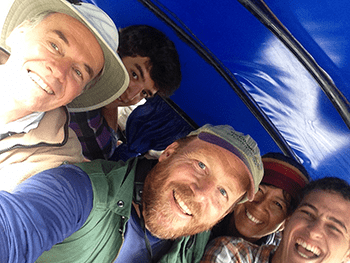
Several of us followed the locals’ lead. We sloshed through the mud and hailed one of Peru’s motorcycle taxis, which carried all five of us plus the driver and his father into town. We passed the time at a nearby reserve looking at Marvelous Spatuletails until the road cleared. But by this point we were at least four hours behind schedule. No time for birding in the cloud forest, we were told. We’d have to drive right past the sunangels.
By the time we reached the Fondo Alto Nieva property in Alto Mayo, I had pleaded pitifully enough to be awarded exactly 10 minutes (“y nada mas! Por el reloj!”) by tour director Manuel Bryce to look for the birds at a set of feeders they often frequent. We ran down the wet path, slipping in the gray clay mud.
At first there was too much to look at. A Booted Racket-tail was dashing up to the first of three feeders. This is a tiny green hummingbird about the size of a stick of gum, with a long flowing tail tipped with two black ovals. Next the female showed up without the fancy tail but with fluffy cream-colored tufts on her legs. Next came a tiny Greenish Puffleg, with a similar leg-warmer getup that was bright white instead of tan. These two were summarily chased off by a slender hummingbird with a long straight bill and an elegant, tapering head. A Violet-fronted Brilliant. Next came a Bronzed Inca.
It was like a hummingbird flash mob, with blurs and duels and electric chip notes flying left and right. But at some point, a darker shape started to appear and then disappear into the foliage. Gradually it began to linger, and eventually—seemingly whenever the brilliant was off chasing pufflegs (did I just say that? Peru is amazing), it resolved into a slim, elegant, steely blue hummingbird with a long, forked tail. It sipped from the feeder, backed off, hovered motionless for a while, took a perch, and returned to the feeder.
We whispered field marks to each other, at least as awestruck by our luck as by the colors of the sunangel. We could see even the few wisps of white down Fitz had noted nearly 40 years ago as a “small, semi-concealed patch of downy white feathers on crissum.” The rest of the bird was as glitteringly blue as deep space.
We spent the rest of the day dropping down the Amazonian side of the Andes. We saw clouds more hummingbirds, shrieking parakeets, a strange bird called an Oilbird, and much more. The competing teams added some 150 new species to their lists today alone. But for me, those five minutes at approximately 2:20 p.m. local time were the pinnacle of the trip. It was the convergence of a spectacular bird, some spectacular luck, and a small piece of history hovering before me in midair.
Going into the second-to-last day of competition in the World Birding Rally, the standings are: In first, Sunbird/Wings with 478 species. In second, Field Guides with 468. In third, Surbound Expeditions with 414. In fourth, Birding Ecotours with 409. Now that we’re down in the hyper-diverse lowlands, the difference between first and last place could be decided by a couple of big foraging flocks—so it’s still anybody’s game. Check for tomorrow’s standings on the World Birding Rally Facebook page—and we’ll post a full wrap-up on Tuesday.
More about the Rally:
- Be Careful What You Wish For: A Punter’s Guide to the World Birding Rally – 10,000 Birds
- The Strange Endemics of the Tumbesian Region – Nature Travel Network
- In the Valley of the Endangered, Endemic White-winged Guan
- Scads of Storm-Petrels on Pre-Rally Pelagic – Nature Travel Network
- Follow the World Birding Rally on Facebook for updates on the competition
- Meet the teams: The World Birding Rally teams are composed of tour leaders from four companies: Birding Ecotours (South Africa, led by Duan Biggs); Wings/Sunbird (U.K./U.S., led by Rich Hoyer); Surbound Expeditions (Florida, led by Alfredo Begazo); and Field Guides (Texas, led by Rose Ann Rowlett).

All About Birds
is a free resource
Available for everyone,
funded by donors like you
American Kestrel by Blair Dudeck / Macaulay Library

